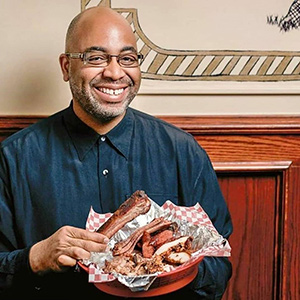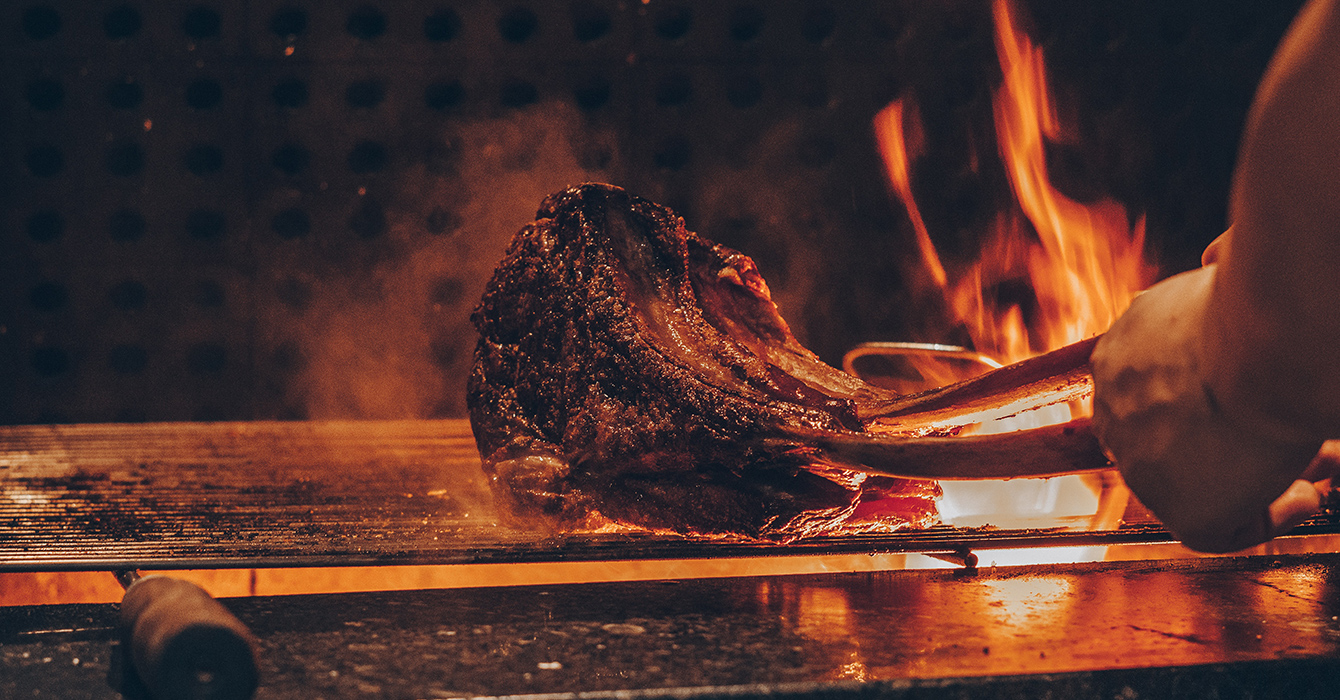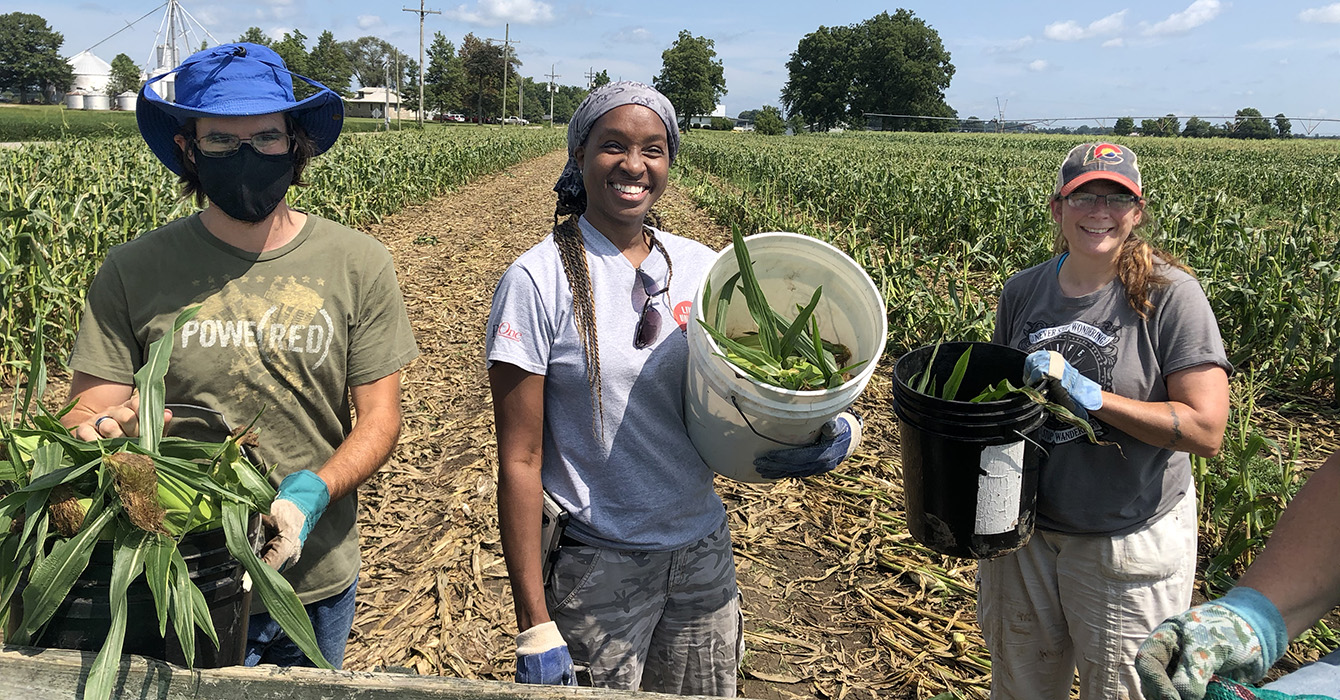Editor’s note: Miller wrote a 2015 piece for Faith & Leadership titled “Toward a theology of barbecue” that was, in part, a foundation for this book.
Before exploring other aspects of African American barbecue culture, it’s important to consider its connection to religion. Barbecue is about building community, and the Black church was arguably the first autonomous institution shaped by African Americans in the United States. As we’ll see, barbecue was useful in creating a multitude of believers.

I begin by confessing, which seems entirely appropriate for a discussion of how barbecue and spirituality intersect. As a Christian and lifelong member of the African Methodist Episcopal Church, I bare my soul and share with you that barbecue has been quite distracting to my spiritual life. When I think about the book of Exodus from the Hebrew Bible, in which Moses encounters the burning bush, I wonder if it smelled like hickory, mesquite, or oak wood. Do you also wonder, as I do, if, when the Prophet Ezekiel had a vision about a “valley full of dry bones,” they looked like a pile of spareribs? Does your mind wander whenever you read the words “burnt offering” in passages like this one from the prophet Micah in the Hebrew Bible:
With what shall I come before the Lord
and bow down before the exalted God?
Shall I come before him with burnt offerings,
with calves a year old?
Will the Lord be pleased with thousands of rams,
with ten thousand rivers of olive oil?
With that scripture, clearly the prophet Micah wrote of beef barbecue with a sauce, right? I know. I have problems, and I need spiritual — and probably other forms of — counseling.
Despite my foibles, it’s undeniable that more than any other cuisine in the United States, barbecue is often served with a side of religious fervor. The atmosphere and language that surround barbecue, the words and phrases that food critics and aficionados use to describe it, are often rooted in things spiritual and holy. Even among the most secular, barbecue and religious imagery seem to go hand in hand. Food writers, for example, gush about “the scales falling from [their] eyes” after eating superlative barbecue nowhere near Damascus (at least not the one in Syria — although maybe the one in Georgia). Pitmasters are likened to preachers, and their barbecue pits, pulpits from which the holy “word” is served.

A barbecue joint in Denver once proudly claimed to serve “nondenominational barbecue.” Rather than taking sides in the sectarian divisions of the barbecue world and committing to a particular style — Kansas City, Memphis, North Carolina, South Carolina, or Texas — this restaurant took an ecumenical approach, drawing from each to create something new, something “quintessentially Coloradan.” This ecumenical approach, the word “eclectic” is more apt, didn’t work well for this particular restaurant (it closed a few months later), but it’s far from heresy. Newer barbecue restaurants often take the approach of an itinerant elder: the owners have traveled the country, sampled the best barbecue, got trained in the proper techniques, and compiled an eclectic menu that they now serve to you — and you should feel blessed by their hard work.
The religious vibe of many African American-owned barbecue restaurants is unmistakable. There’s religious iconography everywhere. Faith-based inspirational sayings and scriptures are commonplace decorations. Gospel music is piped through the sound system, a sharp contrast to the baby-making music of Barry White and Marvin Gaye that is often played at soul food establishments. Depending on the age of the restaurant, portraits of Jesus Christ and the Reverend Dr. Martin Luther King Jr. hang on the wall. Abraham Lincoln, John F. Kennedy, and Barack Obama might have an honored place, too, as a short canon of secular, presidential saints. The staff tells you how they are blessed, and they wish God’s blessings upon you. Even sales receipts offer a benediction. Also, not a drop of alcohol is sold, antithetical to the idea that good barbecue must be paired with beer. To drive the connection home, some restaurants have religious names. In Anne Arundel County, Maryland, one longtime joint was known as “Homer Hall’s Dixie Pig, the King Is Here, and Church of God, the Gate of Heaven Church.” Hall supposedly grilled on converted jailhouse doors. When you dine in one of these restaurants, it’s not like you’re going into a temple. It’s more like being welcomed into a religious person’s home.
Barbecue restaurants are gathering places that also have the power to bring wandering souls closer to God. Pauline J. Coffee “had a glamorous career. A former movie actress and dance hall singer, she was once a partner of the well-known comic actor Stepin Fetchit, both on stage and in the movies.” After a religious conversion to Christianity in 1929 at Doc Hamilton’s Barbecue Pit in Seattle, Washington, she became known as “the Converted Actress.” … Maybe it was because of all that sin that she witnessed up close in his restaurant. Anyway, “She started preaching seven months after conversion and was ordained by Aimee Semple McPherson and was known as the colored evangelist of Angeles Temple.” Coffee’s career lasted into the 1970s and was marked with success as well as some controversies, including a nervous breakdown and a mysterious disappearance. At least one Cleveland pastor lost his job for allowing Coffee to preach from the pulpit in 1939 — something that some conservative Christians won’t allow women to do.
Black barbecue restaurateurs looked to divine texts and Black church culture for inspiration. I don’t know when the words “church” and “barbecue” were first joined, but the “church barbecue” has a rich and long history in the United States. For African Americans, it began with the spiritual lives of the enslaved.
Enslaved West Africans didn’t arrive in the Americas as blank slates in terms of spiritual belief and practice. Many brought their traditional West African spiritual beliefs with them, and others brought Islam. Yet Christianity is the dominant faith tradition in the United States, and so I focus on its influence on Black barbecue traditions. During slavery, Christianity and barbecue were connected via Christmas.
In the antebellum South, the Christmastime barbecue was highly anticipated. As Easter Reed, who grew up on a Georgia plantation, remembered: “On Christmas and the Fourth of July big celebrations were held for the slaves. They either visited other plantations or had guests of their own on those days. Games and dances lasted all day. One of the most interesting events of the day was the feast served about one o’clock. Generally, on the Fourth of July, they enjoyed a fish fry. At Christmas time a pig was barbecued.” Reed’s memories indicate that regional and seasonal differences existed toward July Fourth barbecues but the Christmas barbecue was a uniform practice.
For whites, Christmas barbecues had deeper cultural meaning than other barbecues because of its long ties to European tradition, dating as far back as 1170 CE. In Great Britain, Germany, and some countries in the Balkans and Scandinavia, a boar’s or pig’s head was served on Christmas Eve or Christmas Day. One historian of this tradition notes, “It is difficult to trace how the eating of Boar’s Head came to be connected with the Christmas Feast. … We may possibly find the right reason why … in the 80th Psalm, in which Satan is called ‘the wild boar of the woods.’ In carrying the Boar’s Head in procession and eating it, we show the final defeat of man’s greatest enemy, and what better day to show this than on Christmas Day?” Whites passed this custom along to enslaved African Americans who embraced it and morphed it into a Christmas barbecue tradition that lasted long after Emancipation.
An elderly resident of New Jersey reflecting on her Virginia childhood during the 1950s said in an interview, “That Christmas was wonderful to me. … We had ’tato pies, coconut pies and chocolate. All different kinds of cakes too. Daddy would kill a pig and he would bar-b-que him in the yard. And we would cook up a whole lot of collard greens.” Don’t think for a moment that Christmas barbecue was solely limited to the South. Barbecue was also a featured dish at antebellum enslaved festivities in the North: “Barbecue was also consumed in great quantities at some Saturday night parties; it was the main dish at all Pinkster [Pentecost Day], Election Day, Camp Meeting, and Christmas holiday feasts.” Enslaved people infused Christmas barbecues with religious meaning as they gradually adopted Christianity.
An enslaved person’s conversion to Christianity was highly shaped by the racial and spiritual attitudes of enslavers who often had differing opinions. Some slaveholders discouraged proselytizing Christianity because it conferred a level of humanity on enslaved people, thus undermining one of the strongest rationales for slavery. In these situations, the enslaved had to worship in secret. There were also slaveholders who allowed their enslaved to become Christians: some because they genuinely believed it would be of personal benefit, others because they thought religion would make the enslaved easier to control. Either way, Christianity was typically presented to the enslaved in an unattractive way. When white preachers preached to the enslaved, their “sermons” emphasized the scriptures that supported slavery and obeying one’s master. During the long period of chattel slavery in the antebellum South, proselytizing was scattershot, church buildings were scarce, and many of the enslaved were unchurched. Barbecue gradually became associated with three distinct expressions of Black worship.
One is the “invisible church” which was the coined term for surreptitious worship by enslaved people. They would sneak into the woods at night to avoid detection by the enslaver or the overseer. Barbecue, as an after-worship meal, heightened the anticipation for the worship experience, if the enslaved could “lay hands” on a pig and successfully “liberate” it from the enslaver. Barbecue was well suited for secret meals because it could be made in a variety of locations, required little equipment, and was cooked in a way that lessened the chance of detection. In terms of cooking location, any open space with a nice patch of diggable ground and plenty of wood nearby did the trick. In terms of equipment, trenches could be dug by hand, and the cooks needed only something sharp enough to butcher and process the pig. With fried chicken or fish, one would have to lug around iron cooking equipment and oil. Plus, who knows how long it would take to catch a fish. Thus, barbecue could be easier to make.
Last, there’s the question of detection. A scholar on Black religion surmises: “To avoid detection, [a pig] was placed in a hole dug in the ground and cooked with coals from aromatic firewood, hence the hickory and oak flavors. The pig was wrapped in leaves to prevent the skin from burning and packed with herbs found in the nearby woods. The smoke could not be seen from the big house in the night and there was no flame to give the worshippers away.” The fact that this method required glowing coals instead of a raging fire was key. After the worship and meal were over, the enslaved slipped back to their plantation cabins.
Most religious enslaved people experienced a second type of church the way Jasper Battle did, confined and segregated in an indoor building:
Slaves went to de white folks’ church and listened to de white preachers. Dere warn’t no colored preacher ’lowed to preach in dem churches. Dey preached to de white folks fust and den dey let de colored folks come inside and hear some preachin’ atter dey was through wid de white folks. But on de big ’vival meetin’ days dey ’lowed de N—s to com in and set in de gallery and listen at de same time dey preached to de white folks. When de sermon was over dey had a big dinner spread out on de grounds and dey had jus’ evvything good t’ eat lak chickens, barbecued hogs and lambs, pies, and lots of watermelons. Us kept de watermelons in de crick ’til dey was ready to cut ’em. A white gentleman, what they called Mr. Kilpatrick, done most of de preachin’. He was from de White Plains neighborhood. He sho’ did try mighty hard to git evvybody to ’bey de Good Lord and keep his commandments.
From “Black Smoke: African Americans and the United States of Barbecue” by Adrian Miller. A Ferris & Ferris Book. Copyright © 2021 by Adrian Miller. Used by permission of the University of North Carolina Press.

















